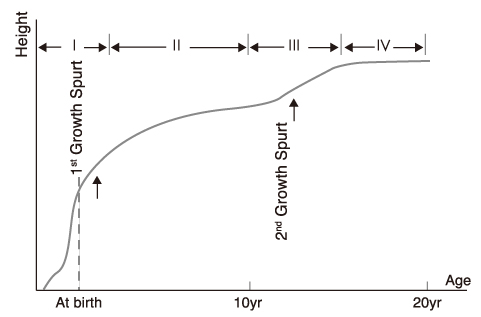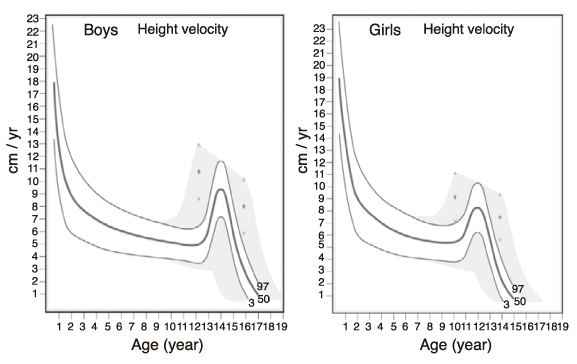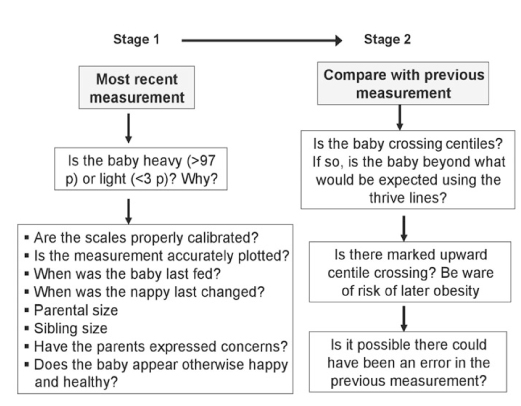J Korean Med Assoc.
2009 Mar;52(3):211-224. 10.5124/jkma.2009.52.3.211.
Monitoring Growth in Childhood: Practical Clinical Guide
- Affiliations
-
- 1Department of Pediatrics, The Catholic University of Korea College of Medicine, Korea. sinky@catholic.ac.kr
- KMID: 2187974
- DOI: http://doi.org/10.5124/jkma.2009.52.3.211
Abstract
- Growth is a potent indicator of child health. The child who grows well is generally healthy, and poor growth reflects his or her ill health. Identification of poor growth acts as a useful early warning of a possible problem. Monitoring children's growth status with appropriate assessments is an important part of pediatrics, and the recognition of growth problems in children is one of the major challenges facing primary care physicians. The process of growth assessment involves measurements of height and/or weight, and sometimes also involves more specialized measurements that are plotted on standard growth charts. In order to identify pathologic growth, a careful history and physical examination should also be obtained. The purpose of this article is to provide information for primary care physicians to guide the assessment of growth in children. Tools to assist in the assessment of growth are discussed as well as normal growth patterns of children.
Keyword
MeSH Terms
Figure
Reference
-
1. Mascie-Taylor CG. Biosocial influences on stature: a review. J Biosoc Sci. 1991. 23:113–128.
Article2. Gibson AT, Carney S, Cavazzoni E, Wales JK. Neonatal and post-natal growth. Horm Res. 2000. 53:s. 42–49.
Article3. Reiter EO, Rosenfeld RG. Kronenberg HM, Melmed S, Polonsky KS, Larsen PR, editors. Normal and aberrant growth. Williams textbook of endocrinology. 2007. 11th ed. Philadelphia: Saunders;849–856.4. Lampl M, Veldhuis JD, Johnson ML. Saltation and stasis: a model of human growth. Science. 1992. 258:801–803.
Article5. Wehr TA. Effect of seasonal changes in daylength on human neuroendocrine function. Horm Res. 1998. 49:118–124.
Article6. Kim YT, Lee CK, editors. Child and adolescence standard growth chart. Korea Centers for Disease Control and Prevention, Korean Pediatric Society. 2007. 1–60. Also available from, http://www.cdc.go.kr/kcdchome.portal?_nfpb=true&_pageLabel=HPPUNI130&rootmenuid=20010&boardid=171&boardtype=BRDTYPE01&boardseq=20915http://www.cdc.go.kr/kcdchome.portal?_nfpb=true&_pageLabel=HPPUNI130&rootmenuid=20010&boardid=171&boardtype=BRDTYPE01&boardseq= 20915.7. Völkl TM, Haas B, Beier C, Simm D, Dörr HG. Catch-down growth during infancy of children born small (SGA) or appropriate (AGA) for gestational age with short-statured parents. J Pediatr. 2006. 148:747–752.
Article8. Hokken-Koelega AC, De Ridder MA, Lemmen RJ, Den Hartog H, De Muinck Keizer-Schrama SM, Drop SL. Children born small for gestational age: do they catch up? Pediatr Res. 1995. 38:267–271.
Article9. Karlberg JP, Albertsson-Wikland K, Kwan EY, Lam BC, Low LC. The timing of early postnatal catch-up growth in normal, full-term infants born short for gestational age. Horm Res. 1997. 48:S. 17–24.
Article10. Sorva R, Tolppanen EM, Lankinen S, Perheentupa J. Growth evaluation: parent and child specific height standards. Arch Dis Child. 1989. 64:1483–1487.
Article11. Nwosu BU, Lee MM. Evaluation of short and tall stature in children. Am Fam Physician. 2008. 78:597–604.12. Blizzard RM, Johanson A. Kappy MS, Blizzard RM, Migeon CJ, editors. Disorders of growth. Wilkins the diagnosis and treatment of endocrine disorders in childhood and adolescence. 1994. 4th ed. Springfield: Thomas;383–429.13. Kjellberg H, Beiring M, Albertsson Wikland K. Craniofacial morphology, dental occlusion, tooth eruption, and dental maturity in boys of short stature with or without growth hormone deficiency. Eur J Oral Sci. 2000. 108:359–367.
Article14. Gaethofs M, Verdonck A, Carels C, de Zegher F. Delayed dental age in boys with constitutionally delayed puberty. Eur J Orthod. 1999. 21:711–715.
Article15. Loevy HT, Aduss H, Rosenthal IM. Tooth eruption and craniofacial development in congenital hypothyroidism: report of case. J Am Dent Assoc. 1987. 115:429–431.
Article16. Cole TJ. Assessment of growth. Best Pract Res Clin Endocrinol Metab. 2002. 16:383–398.
Article17. Baird J, Fisher D, Lucas P, Kleijnen J, Roberts H, Law C. Being big or growing fast: systematic review of size and growth in infancy and later obesity. BMJ. 2005. 331:929–931.
Article18. Fomon SJ. Reference data for assessing growth of infants. J Pediatr. 1991. 119:415–416.
Article19. Freeman JV, Cole TJ, Wales JKH, Cooke J. Monitoring infant weight gain: advice for practitioners. Community Pract. 2006. 79:149–151.20. Hagenäs L, Hertel T. Skeletal dysplasia, growth hormone treatment and body proportion: comparison with other syndromic and non-syndromic short children. Horm Res. 2003. 60:S. 65–70.
Article21. Engstrom FM, Roche AF, Mukherjee D. Differences between arm span and stature in white children. J Adolesc Health Care. 1982. 2:19–22.
Article22. Lifshitz F, Botero D. Lifshitz F, editor. Worrisome growth. Pediatric Endocrinology. 2006. 5th ed. New York: Marcel Dekker;1–82.23. Keane V. Kliegman RM, Behrman RE, Jenson HB, Stanton BF, editors. Assessment of growth. Nelson textbook of pediatrics. 2007. 18th ed. Philadelphia: Saunders;70–74.24. Wright CM, Cheetham TD. The strengths and limitations of parental heights as a predictor of attained height. Arch Dis Child. 1999. 81:257–260.
Article25. Tanner JM, Goldstein H, Whitehouse RH. Standards for children's height at ages 2-9 years allowing for heights of parents. Arch Dis Child. 1970. 45:755–762.
Article26. Bayley N, Pinneau SR. Tables for predicting adult height from skeletal age: revised for use with the Greulich-Pyle hand standards. J Pediatr. 1952. 40:423–441.
Article27. Lenko HL. Prediction of adult height with various methods in Finnish children. Acta Paediatr Scand. 1979. 68:85–92.
Article28. Cox LA. The biology of bone maturation and ageing. Acta Paediatr. 1997. 423:S. 107–108.
Article29. Poyrazoğlu S, Günöz H, Darendeliler F, Saka N, Bundak R, Baş F. Constitutional delay of growth and puberty: from presentation to final height. J Pediatr Endocrinol Metab. 2005. 18:171–179.30. Tanner JM, Prader A, Habich H, Ferguson-Smith MA. Genes on the Y chromosome influencing rate of maturation in man: skeletal age studies in children with Klinefelter's (XXY) and Turner's (XO) syndromes. Lancet. 1959. 274:141–144.31. Frasier SD. Lifshitz F, editor. Tall stature and excessive growth syndrome. Pediatric Endocrinology. 2006. 5th ed. New York: Marcel Dekker;227–252.
- Full Text Links
- Actions
-
Cited
- CITED
-
- Close
- Share
- Similar articles
-
- Invention of the Guide Catheter Irrigation Monitoring Device for Neuroendovascular Therapy
- Truly practical, a book review for Teaching Anatomy: A Practical Guide
- Practical Guide to Clinical Data Management by Susanne Prokscha, 2007
- Short Stature and Growth Hormone Therapy
- Satisfaction with Evaluation Method for Fundamental Nursing Practical Skill Education Through Cell Phone Animation Self-Monitoring and Feedback: Focus on Foley Catheterization





